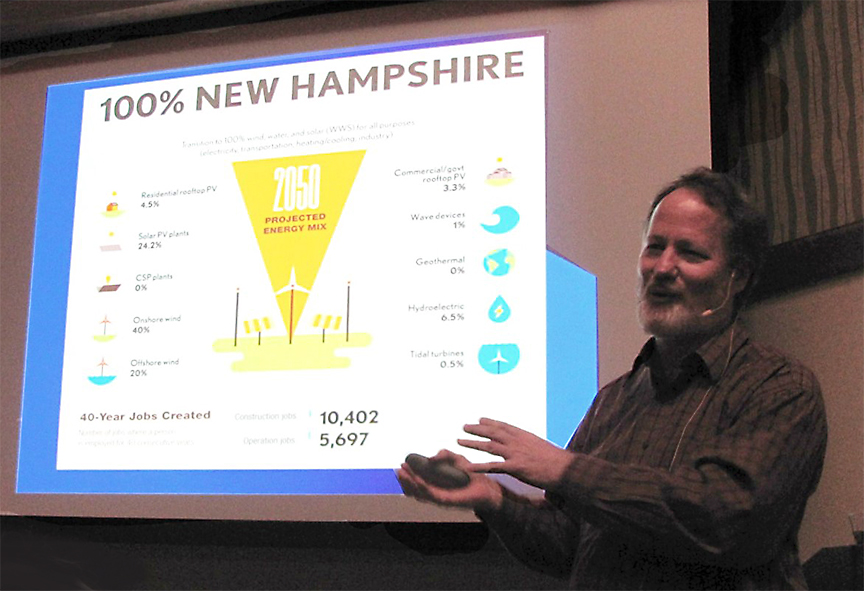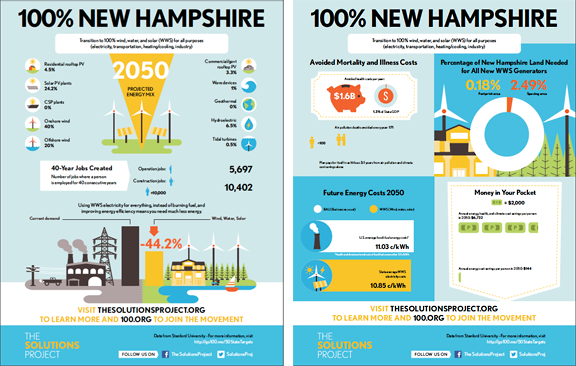Promoting a 100% Renewable Energy Strategy by 2050
SAPL is working to promote a strategy to have New Hampshire on 100% renewable energy by the year 2050. This endeavor is supported in part by The Solutions Project, a nationwide project created by Mark Z. Jacobson, professor and Director of the Atmosphere and Energy Program at Stanford University.
PHOTO: Getting to 100% Renewables: Doug Bogen presenting What a Fully Sustainable Energy System for New Hampshire Might Look Like.

HOW THE SOLUTIONS PROJECT WORKS
Converting the entire world’s energy infrastructure to run on clean, renewable energy is a daunting concept, but Mark Jacobson and his colleagues have managed to demonstrate how each of the 50 states can achieve just such a transition by the year 2050. While these plans undoubtedly call for aggressive changes, the study shows that this conversion is in fact technically and economically feasible and that it can happen right now. Jacobson ran this study with real data, considering the true costs and benefits of various energy sources, and with technology that already exists.
Each state’s roadmap was carefully crafted to map out the most likely and viable combination of wind, water, and solar power for that specific region. The plans have each state at 80% renewable energy by 2030 and 100% renewable by 2050, and they also take into consideration the overall costs and benefits of the process. Factors considered include job creation, mortality and illness, and projected changes in energy costs and usage.
“The main barriers are social, political and getting industries to change. One way to overcome the barriers is to inform people about what is possible. By showing that it’s technologically and economically possible, this study could reduce the barriers to a large scale transformation.” – Mark Jacobson, The Solutions Project
How 100% can work for New Hampshire
INFOGRAPHIC: Click on the image to view an overview of the 100% New Hampshire plan courtesy of The Solutions Project.
100% plans are adaptable. For example, given the ongoing challenges of siting onshore wind farms in New Hampshire and the greater potential for offshore wind, we believe that reversing the percentages for each (to 40% offshore and 20% onshore) would be more feasible.
How can anyone possibly model anything so complicated?
Not just anyone could create a model with this level of accuracy and integrity. The team that worked on The Solutions Project are second-to-none. Jacobson alone has a bachelor’s degree in civil engineering, a second bachelor’s in economics, a master’s in environmental engineering, a second master’s in atmospheric science, and a PhD in atmospheric science.
The study was run with the highest of standards and the most comprehensive, detailed, well-documented, and well known data projections available. The final study was published in the scientific journal Energy and Environmental Science, and is available on the Stanford University website.
Summary of Jacobson's 100% process by Doug Bogen
Jacobson and his colleagues started by taking a close look at the current energy demands of each state, and how those demands would change under business-as-usual conditions by the year 2050. To create a full picture of energy use in each state, they examined energy usage in four sectors: residential, commercial, industrial, and transportation.
For each sector, they then analyzed the current amount and source of the fuel consumed – coal, oil, gas, nuclear, renewables – and calculated the fuel demands if all fuel usage were replaced with electricity. This is a significantly challenging step – it assumes that all the cars on the road become electric, and that homes and industry convert to fully electrified heating and cooling systems. But Jacobson said that their calculations were based on integrating existing technology, and the energy savings would be significant.
“When we did this across all 50 states, we saw a 39 percent reduction in total end-use power demand by the year 2050,” Jacobson said. “About 6 percentage points of that is gained through efficiency improvements to infrastructure, but the bulk is the result of replacing current sources and uses of combustion energy with electricity.”
The next step involved figuring out how to power the new electric grid. The researchers focused on meeting each state’s new power demands using only the renewable energies available to each state – including wind, solar, geothermal, hydroelectric, and tiny amounts of tidal and wave energy. They analyzed each state’s sun exposure, and how many south-facing, non-shaded rooftops could accommodate solar panels. They developed and consulted wind maps and determined whether local offshore wind turbines were an option. Geothermal energy was available at a reasonable cost for only 13 states. The plan calls for virtually no new hydroelectric dams, but does account for energy gains from improving the efficiency of existing dams. We at SAPL would quibble with the figures for offshore/onshore wind for New Hampshire, given the ongoing challenges of siting onshore wind farms in our state and the greater potential for offshore wind. We believe that reversing the percentages for each seems more reasonable for New Hampshire.
The report lays out individual roadmaps for each state to achieve an 80 percent transition by 2030, and a full conversion by 2050. Jacobson said that several states are already on their way.
The plan calls for no more than 0.5 percent of any state’s land to be covered in solar panels or wind turbines. The upfront cost of the changes would be significant, but wind and sunlight are free. So the overall cost spread over time would be roughly equal to the price of the fossil fuel infrastructure, maintenance and production.
“When you account for the health and climate costs – as well as the rising price of fossil fuels – wind, water and solar are half the cost of conventional systems,” Jacobson said. “A conversion of this scale would also create jobs, stabilize fuel prices, reduce pollution-related health problems and eliminate emissions from the United States. There is very little downside to a conversion, at least based on this science.”
Jacobson said that if the conversion is followed exactly as his plan outlines, the reduction of air pollution in the U.S. could prevent the deaths of approximately 63,000 Americans who die from air pollution-related causes each year. It would also eliminate U.S. emissions of greenhouse gases produced from fossil fuel, which would otherwise cost the world $3.3 trillion a year by 2050.
WHAT YOU CAN DO
- Support SAPL so we can continue forging ahead!
- Learn about the WindASSIST project and our current progress on Offshore Wind in New Hampshire. Things are happening!
- Visit THE SOLUTIONS PROJECT to learn more about this program.
All data is from 100% clean and renewable wind, water, and sunlight (WWS) all-sector energy roadmaps for the 50 United States by Jacobson et al

